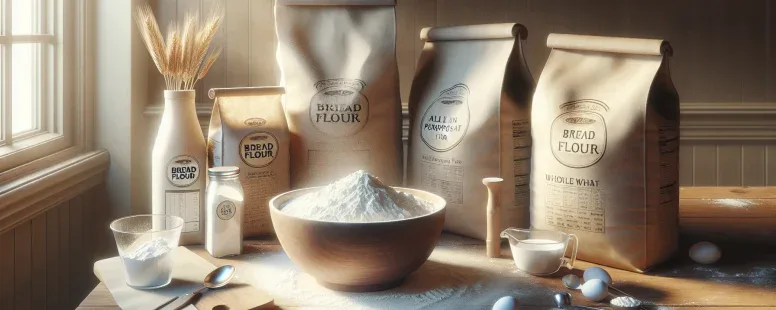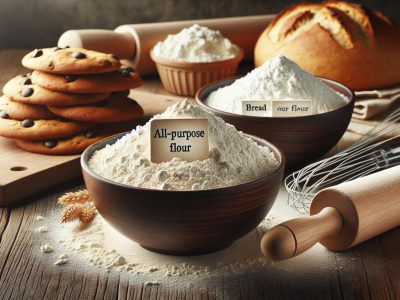Best Substitute for Bread Flour: Top Alternatives & Baking Tips
Baking has a way of filling your kitchen with warmth and the irresistible scent of freshly made bread. But what happens when you’re halfway through a recipe, only to realize you’re out of bread flour? Don’t let that derail your culinary plans. The good news is, there are plenty of substitutes that can step in without compromising the texture or flavor of your baked goods.
What Is Bread Flour And Why Is It Used?
Bread flour is a high-protein wheat flour designed specifically for baking bread. Its protein content, ranging from 12% to 14%, creates more gluten when hydrated and mixed. Gluten provides structure and elasticity, essential for achieving chewy textures in baked goods like artisan loaves or pizza crusts.
This type of flour absorbs more water compared to all-purpose flour, allowing doughs to develop stronger structures during kneading. This property makes it ideal for recipes requiring significant rise, like sandwich bread or baguettes. For example, using bread flour ensures tall and airy results in sourdough baking.
You might wonder if other flours can replicate these effects? While substitutes exist, none match the balance of elasticity and strength provided by bread flour without adjustments to hydration levels or mixing techniques.
Common Substitute For Bread Flour
When bread flour isn’t available, several alternatives can replicate its purpose in recipes. Each substitute has unique properties that may require slight adjustments for optimal results.
All-Purpose Flour
All-purpose flour is the most accessible replacement for bread flour. With a lower protein content (around 10% to 12%), it produces less gluten, leading to softer doughs. Use an equal amount of all-purpose flour in place of bread flour but knead longer to develop sufficient gluten structure. For better elasticity, you can add 1 teaspoon of vital wheat gluten per cup of all-purpose flour.
Whole Wheat Flour
Whole wheat flour offers a denser texture due to its bran and germ content, which interferes with gluten formation. Replace up to 50% of the bread flour with whole wheat flour for a balanced result or use it entirely for hearty loaves like artisan bread. Increase hydration slightly since whole wheat absorbs more water than white flours.
Gluten-Free Flour Blends
Gluten-free blends are suitable when avoiding gluten is necessary. They often consist of rice flour, tapioca starch, and xanthan gum to mimic the elasticity provided by gluten. Choose blends labeled “for baking” as they’re formulated for leavened goods like bread. Adjust liquid amounts slowly since these blends vary in absorption rates significantly compared to traditional flours.
Specialized Alternatives To Bread Flour
Specialized alternatives allow you to experiment with textures, flavors, and nutritional profiles in your baked goods. While these substitutes deviate from traditional bread flour, they bring unique qualities that can elevate your recipes.
Vital Wheat Gluten
Vital wheat gluten enhances dough elasticity and structure. It’s made by hydrating wheat flour to activate gluten, then removing starches. Add 1-2 tablespoons per cup of all-purpose or whole wheat flour to mimic bread flour’s protein content. For example, adding vital wheat gluten works well for artisan breads like sourdough or ciabatta. Ensure even mixing to avoid clumping in the dough.
Spelt Flour
Spelt flour offers a nutty flavor and lighter texture compared to whole wheat. Use it as a partial substitute—replace up to 50% of bread flour—to maintain structure while introducing spelt’s distinct taste. Full substitution is possible but results in denser loaves; increase kneading time slightly due its lower gluten strength.
Tips For Using Bread Flour Substitutes
When you switch to bread flour substitutes, adjustments to liquid ratios, mixing techniques, and baking parameters ensure success. Small changes can improve texture and rise while maintaining the flavor and structure of your baked goods.
Adjusting Liquid Ratios
Substitutes like all-purpose or whole wheat flour absorb water differently than bread flour. Measure liquids carefully; begin with 10-15% less water than the recipe calls for if using all-purpose flour. Gradually incorporate more if the dough feels dry or crumbly during mixing. Whole wheat flour often needs slightly more hydration due to its bran content absorbing moisture, so add 1-2 tablespoons extra water per cup used.
Gluten-free blends require particular attention because their starches vary in absorption rates. An overly wet dough may lead to spreading instead of rising properly, so balance hydration cautiously for these blends.
Mixing And Kneading Tips
Developing gluten is crucial with substitutes lacking bread flour’s high protein content. Knead longer when using lower-protein flours like all-purpose or spelt; aim for 8-12 minutes by hand compared to typical kneading times. Check elasticity by performing a windowpane test—stretch a small piece until thin enough to see light without tearing.
For gluten-free alternatives, kneading doesn’t develop structure but ensures even distribution of ingredients and air pockets. Use a stand mixer on medium speed for consistent results in gluten-free baking.
Baking Time And Temperature Adjustments
Substitutes impact browning and cooking times slightly due to differing protein levels affecting Maillard reactions (browning process). Lower-protein flours might brown faster but leave interiors undercooked if temperatures aren’t adjusted. Reduce oven heat by 25°F after initial crust formation or tent loaves with foil halfway through baking.
Doughs made with whole wheat substitute bake longer at reduced temperatures—typically an additional 5-10 minutes at around 375°F—to prevent dense centers while encouraging proper rise throughout loaf sizes varying from rolls to sandwich loaves.
Pros And Cons Of Bread Flour Substitutes
Advantages of Bread Flour Substitutes
- Accessibility: Bread flour substitutes like all-purpose or whole wheat flour are widely available in most grocery stores, making them convenient when bread flour is unavailable.
- Versatility: Using substitutes allows you to experiment with different flavors and textures; for example, spelt flour adds a nutty flavor, while whole wheat provides a hearty density.
- Dietary Adaptability: Gluten-free blends cater to those with dietary restrictions, offering alternatives without compromising baking possibilities.
Disadvantages of Bread Flour Substitutes
- Texture Variations: Substitutes often result in denser or less elastic dough compared to bread flour; for instance, whole wheat loaves may feel heavier due to their lower gluten content.
- Structural Compromise: Lower-protein flours require longer kneading or additional vital wheat gluten to achieve similar elasticity and strength as bread flour.
- Hydration Adjustments: Different absorption rates necessitate careful liquid measurement; using all-purpose flour may need 10-15% less water initially, while whole wheat requires more hydration.
Practical Examples
- Replacing 100% bread flour with all-purpose can lead to minor differences in rise but works well for softer recipes like dinner rolls.
- Baking rustic loaves with spelt or rye often creates unique crumb structures but demands precise hydration tweaks.
- Gluten-free pizza dough might lack elasticity unless formulated mixes are used alongside binders like xanthan gum.
Understanding these factors helps you choose the best substitute based on recipe needs and desired outcomes.
Conclusion
Finding a substitute for bread flour doesn’t have to derail your baking plans. With the right adjustments and a little experimentation, you can achieve excellent results that suit your recipe and preferences. Whether you’re using all-purpose flour, whole wheat, or gluten-free blends, understanding how each option behaves helps you create delicious baked goods every time. Embrace the opportunity to explore new textures and flavors while keeping your baking flexible and rewarding.
- Pros and Cons of Partnerships: Key Benefits and Challenges to Consider - October 29, 2025
- King vs Queen Size Bed: An In-Depth Comparison for Your Perfect Mattress Choice - October 29, 2025
- Krill Oil vs Fish Oil: Key Differences, Benefits, and Choosing the Right Omega-3 Source - October 29, 2025







